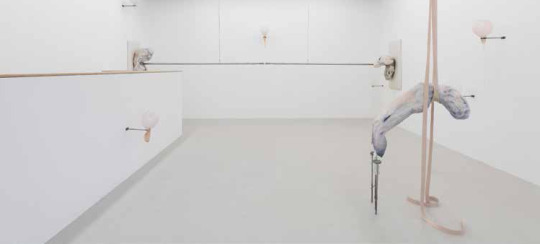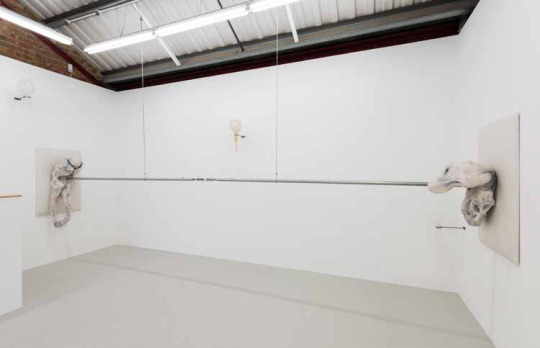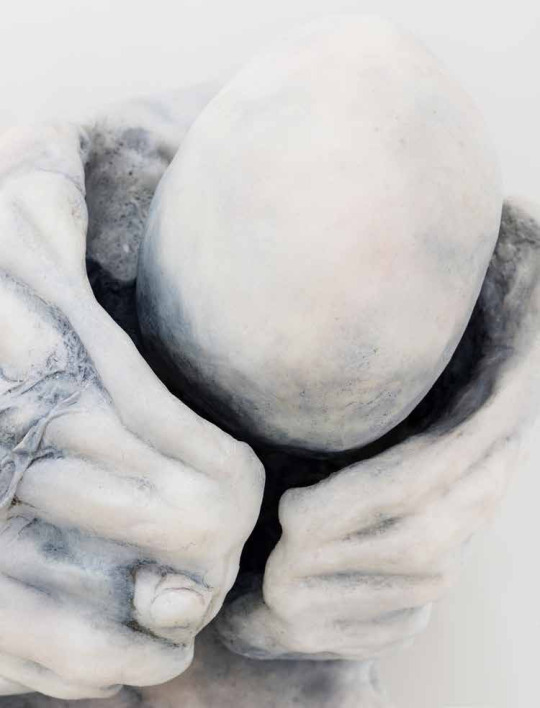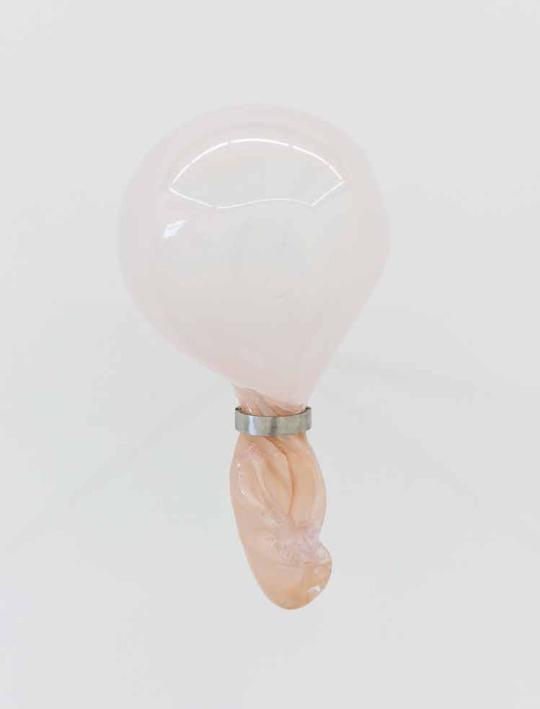131. Ivana Basic

Ivana Basic, Throat Wanders Down a Blade Installation shot, 2016. Mixed materials; dimensions variable. © Annka Kultys. Courtesy the artist and Annka Kultys Gallery.
Ivana Basic’s first UK solo exhibition, ‘Throat Wanders Down a Blade’, is currently on show at Annka Kultys Gallery, London. Using written narrative and drawings alongside sculpture; Basic both navigates and interrogates the psychic and physical materiality of human existence. She discusses the uncontrolled body, societal constructs of identity and the further concepts which drive her practice with Charlotte Barnard for Traction.
Your sculptural work has become increasingly figurative, moving away from the fleshy abstraction that dominated your earlier practice. Whilst becoming more figurative, the corpulent objects remain alien, often described as ‘uncanny’. Please could you discuss how you see the relationship between the two and what drove this move?
I think my work has always been fully figurative, yet there are multiple approaches to figuration. You can discuss the body through the presence of the body or, you can discuss it through the absence of the body. Both of these positions have the same value, yet they are coming from different sides.
I think the shift that has happened from the previous body of work was that I was dissecting the body from the outside, looking at the surface, looking at the skin, looking at the pose, and looking at the volume. In ‘Throat Wanders Down the Blade’, I am inside of the body and looking out. I am looking at what happens in the confines of that limited space, which is our habitat. The pieces feel very ghostly; they are phantoms of something that is contained inside and formless. I created a body for it, so it is really about externalising what is within. This is why the colours are drained; there is no need for skin anymore.
The notion of the ‘uncanny’, on the other hand, is a very potent feeling. I can’t help but keep recreating it through my work. It is a result of the fact that, in my work, the body is given autonomy. This allows it certain potency and, as you said, renders it alien. In doing so we have announced that the body can’t be contained or controlled and this is something that generates fear. I feel that through my work I am taking down the veil and revealing the brutal yet truthful and inevitable nature of the uncontrolled body. This is at the same time the truth of all of us.

Ivana Basic, Throat Wanders Down a Blade Installation shot, 2016. Mixed materials; dimensions variable. © Annka Kultys. Courtesy the artist and Annka Kultys Gallery.
Your show 'Throat Wanders Down a Blade’ sees you introducing a written narrative element alongside the physical material. What prompted this?
For this show I wanted to use the opportunity of working together with the writer Courtney Malick and working with language to communicate what couldn’t be communicated through material pieces; that is the voice.
Throughout the show the character of Bridle is being materialised. Bridle emerged as a way for me to name and address the two forces I have been employing in my work so far. One being the force that propels life forward, and the other being the force that constrains life in order to bring its fragility and temporality to the fore. The wax sculptures in the show represent Bridle’s body as she moves through the different forms; the glass vessels on the walls represent her breath, and the written piece represents her voice. These are the three elements that make her presence in the space a reality and they all reinforce each other. The viewer in this show is really an intruder, which is why the pieces in the show are hiding their faces away from the visitors.
By allowing the audience to hear her speak, I would also allow them to pass the border of the skin and enter those bodies, be in there with her, and look through her eyes. It was my hope that by doing so, people would realise that the story of Bridle is really a story of all of us.

Ivana Basic, Population of Phantoms Representing Me #1 (detail), 2016. Wax, oil paint, pressure, weight,stainless steel, leather; 110 x 37 x 40 cm (43 ½ x 14 ½ x 15 ¾ in). © Annka Kultys. Courtesy the artist and Annka Kultys Gallery.
Following on from this, in previous digital work such as 'SOMA’ you named the figurative identities created. Here, in 'Throat Wanders Down the Blade’, we similarly are met with the alien-like figures of Bridle, your named, created entity. How do you feel the decision to include a name and character for the work affects its relationship with the viewer and their position within it?
The name in the ‘SOMA’ project had a purpose, to act as a product name. To dissociate the name from the identity, just like the creation of the digital bodies made to be sold, was dissociating the body from the identity.
The name of Bridle in ‘Throat Wanders Down the Blade’ is there as a way for me to be able to address this non material force that creates life and also disappears it. By naming this force I am able to address it and have a conversation with it.
I think of Bridle in terms of solid and void. In order for solid to architecturally survive, it needs to contain the void, therefore, every solid is infected by the void and it is actually a symptom of a void. The only way to talk to the void is to talk to it through the solid. Bridle, for me, is a void, so I named her and gave her a body, which is the solid that contains her, and by handling her body I am able to address her.
From the position of the viewer, I think that the idea of the character allows people to choose how close they want to get to her and how deep they want to go with her, since with this approach you are free to treat Bridle, and what she is, as a fiction or, you are free to take it as the reality.

Ivana Basic, Breath seeps through her tightly closed mouth #6, 2016. Breath, glass, stainless steel torque; 35 x 28 x 28 cm (13 ½ x 11 x 11 in). © Annka Kultys. Courtesy the artist and Annka Kultys Gallery.
In 'Throat Wanders Down the Blade’, you use a broad yet often juxtapositional range of materials to create the works included, for example; wax and glass, leather and metal. Please could you discuss your engagement with these materials and the relationships evident between them?
All the materials in this show, and in my work in general, are very specifically picked. Wax, oil paint and glass are all materials that don’t take a finite form. They can always be remelted or diluted back into their original soft or malleable state. Therefore, form is a temporary state for all of them. Incidentally, the state of both glass and wax, which allows them to maintain a solid form, is at the same time their most fragile state, since when they are liquid they cannot be broken. As the wider aim of my work lays in stretching the limits of the matter, redefining what would be considered as the the end of the matter or the death of the matter, these material properties are fully aligned with that aim.
The leather in the show is actually faux leather, it is a material that simulates skin and has similar value as a silicone I used in some of my previous work. Since silicone is also exceptionally precise in the simulation of skin, but is at the same time like faux leather, plastic, non-real, it therefore creates the illusion of reality.
In ‘Throat Wanders Down the Blade’, the faux skin was used as a support, or comfort material, that was there to offer a temporal release from the pain or momentary support from the fall. However, in the material lies the truth, that this is a simulation it is not the truth.

Ivana Basic, Stay inside or perish (detail), 2016. Wax, glass, pressure, oil paint, weight, rigidity, stainless steel, faux leather, elastic band; 110 x 33 x 45.5 cm (43 ½ x 13 x 18 in). © Annka Kultys. Courtesy the artist and Annka Kultys Gallery.
The ideas you touched upon, regarding the uncontrolled body and its brutal, inevitable nature, were particularly interesting. Could you expand upon this please?
The idea of the ‘normal’ body is based upon the economics of the labour; the body that is able to work is the ‘normal’ body and anything that doesn’t fit into the image of that ‘normal’ body is disqualified and considered ‘DE-formed’, ‘disfigured’, ‘disabled’. In other words, considered as LESS than whole, for being LESS than normal. This is something that in a way speaks about how the idea of wholeness is constructed.
In the past, I worked with a disabled performance artist who was born without a hand, and she would tell me how people would continually stare at the shoulder and always ask: “What happened?” They were looking for a reason behind why she is the way she is. She was born without a hand and she never wanted a hand, she was WHOLE, but it was impossible for others to perceive her as such, exactly because of this economics of labor and the false idea of what a body should be which is constructed through it.
Even within language there is no way to address these different kinds of bodies in a way that is not disqualifying. This comes as a consequence of the fact that ‘man’, as such, is a societal construct, in which the body is supposed to be fully controlled. We put clothes on it and we wash it, so that others don’t have to be aware of our bodies. Anything we do with our bodies, with regards to their materiality, is done in sterile rooms, which can be easily cleaned. As if the body is something dirty, that should be sterilised and should not be visible in its materiality.

Ivana Basic, Stay inside or perish (detail), 2016. Wax, glass, pressure, oil paint, weight, rigidity, stainless steel, faux leather, elastic band; 110 x 33 x 45.5 cm (43 ½ x 13 x 18 in). © Annka Kultys. Courtesy the artist and Annka Kultys Gallery.
Anytime the body comes into visibility, examples of which are bodies that are differently formed, or if one was to not clean their body, wash their hair or bathe, all of these are examples in which one is immediately disqualified from society, since it cannot be allowed for the body to overpower the ‘man’. So really throughout one’s life, Man is made to function in a way that is suppressing the body under the surface and making it obey the social order.
With this in mind, the only times when the body is allowed to exist and be considered in its full materiality is in the pre-natal and post-mortem states of being. Before one is born, your full existence is considered only through the body and its matter, since the ‘character’, or content of the body, is still unknown. After one dies, the body comes to the surface or, if you will, blossoms in its’ full materiality.
There is a great stigmatisation around what the corpse is, and this culture of fear is built around death. In reality, once the body dies it comes to the surface what we have been all along, which had been suppressed or erased from the surface of us, and we were really never supposed to identify with it. So once the mind is gone, and cannot control the body, the body appears in its’ full ‘brutal’, if you will, nature. This is the inevitable truth and future of us all.
These are some of the things my work addresses, so when people say that my pieces are deformed or morbid, it is really a failure of one to accept that this is the reality of the body.

Ivana Basic, Stay inside or perish (detail), 2016. Wax, glass, pressure, oil paint, weight, rigidity, stainless steel, faux leather, elastic band; 110 x 33 x 45.5 cm (43 ½ x 13 x 18 in). © Annka Kultys. Courtesy the artist and Annka Kultys Gallery.
It interests me that you worked with a writer, Courtney Malick, to create Bridle’s voice; two voices to create one. Ideologically and contextually I find that incredibly engaging, especially in reference to your discussion of the universality of Bridle. Would you be able to discuss this and talk about the motives for this collaboration?
Of course, to expand upon your point, there are actually four voices being merged to create Bridle and they have been credited as such in a book. Those are Courtney Malick, myself, Vladimir Nabokov and Franz Kafka. I was embodying myself and both Kafka and Nabokov.
Courtney’s voice on the other hand shaped Bridle from the perspective of knowing my work very well, understanding the emotional weight and nature of Bridle, which is something we together defined along the way.
Speaking of the universality of Bridle, I encounter her in writings of certain authors, and I tend to collect those thoughts. The thoughts of Nabokov and Kafka, I have had in my mind for years, and they started to merge with my own voice. Both Kafka and Nabokov have a relationship to their body that is very similar to my own reality. There is an absolute awareness of the temporality of this vessel we inhabit, its’ space, its’ boundaries, its’ weight its’ smell and there is a failure to identify with that vessel.
Even though their thoughts were threaded in completely different contexts to my own, I know they came from the same place my work comes from, so, inscribing them into Bridle’s voice was a way to activate the full weight and potency of those words.
The text is written in order to relate to the reader the experience of being contained within matter that will expire, within the limited space of the body. I feel the pieces in the show very intensely and I wanted the audience to feel them just as strongly through this text. Courtney offered the name Bridle, referring to the horse harness, as an apparatus to control, hold and constrict the life force.

Ivana Basic, Throat Wanders Down a Blade Installation shot, 2016. Mixed materials; dimensions variable. © Annka Kultys. Courtesy the artist and Annka Kultys Gallery.
When you talk about the void, and Bridle’s representation of this, it brought to mind Frankl’s concept of the 'existential vacuum’; the internal emptiness of an individual, which is concomitant with contemporary, hyper-connected living. Is this something that resonates with your concerns?
Yes there is a definite urge to fill the void within, and with the media and connectivity saturated society it becomes much easier, but also much more symptomatic as to why it is done.
I think that what Frankl was doing, and what I am doing, is peering into the void, allowing it to be and trying to understand the rest of reality through it. Since the void is really the constant, the rest is variable.
Will we see you explore the character of Bridle further?
I think Bridle is an inevitable part of everything I do. I am not sure, at this moment, in which capacity will I address her in future.
Where can we next encounter your work?
The next show I have a piece in is a group show curated by Chrissie Iles: ‘Dreamlands: Immersive Cinema and Art, 1905–2016’ at Whitney Museum of American Art and after that I am preparing for a solo show at Signal Gallery in Brooklyn for Spring 2017.
Interview by Charlotte Barnard.
See ‘Throat Wanders Down a Blade’ (8th September-8th October) at Annka Kultys, Cambridge Heath, London, UK. For further information please visit http://www.annkakultys.com.preview13.oxito.com.
‘Dreamlands: Immersive Cinema and Art, 1905–2016’ at Whitney Museum of American Art, USA. http://whitney.org/Exhibitions.
For information on Ivana’s upcoming solo show at Signal Gallery, Brooklyn follow: http://ssiiggnnaall.com.
To keep up to date with all of Ivana’s news and upcoming shows and to see more of her work, please follow the link to her website: http://ivanabasic.com.